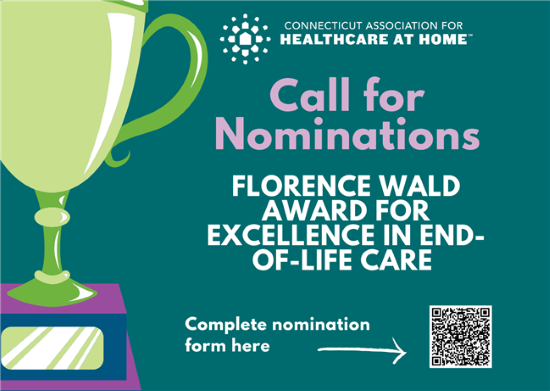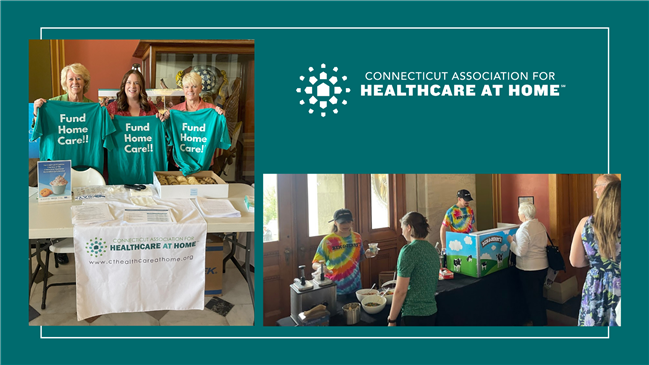 |
|||||||||||||||||||||||||||||||
| April 3, 2025 | |||||||||||||||||||||||||||||||
Last week, the Home Care Association of America Connecticut (HCAOA CT) in collaboration with the Connecticut Association for Healthcare at Home submitted proposed homemaker-companion agency (HCA) caregiver training language amendments to the Aging and Government Oversight Committees.
This language clarifies definitions of homemaker, personal hygiene, and personal care assistants along with establishing training requirements and allowable advertising.
Click HERE to view proposed amendments.
Source: Miriam Miller, CT DPH Policy Director, March 31, 2025
The Department of Public Health (DPH) was notified on Tuesday that 6 of our grants were terminated. This has resulted in almost $150 million of cuts to the agency, and we have spent the last few days working to understand the impacts of this loss.
While I have included a slide deck giving an overview of the work we have done under the grants and the work that will stop as a result of the cuts, I wanted to take a moment to provide clarity on what these funds are for.
These grants are NOT COVID-19 funds as they have been described in the media. While these funds were granted during the COVID-19 pandemic, their purpose was to help build critical public health infrastructure and have helped us modernize our core functions as an agency. This includes modernizing our birth and death registries, moving from a paper-based disease reporting system to an electronic one, and tracking emerging and active diseases like mpox, avian flu, and measles with potential spread throughout the state. As you will see in the slide deck, the loss of these funds will hinder our ability to track and prevent public health crises in our state moving forward and challenge our ability to share real-time information on these crises as they emerge.
Below is some high-level information about the grant cuts and their immediate impacts.
Additional information about the grants can be found in this slide deck.
Source: CT News Junkie
Democratic leaders joined Connecticut Attorney General William Tong on Tuesday in support of a lawsuit against the US Department of Health and Human Services (HHS) and its Secretary Robert F. Kennedy for terminating $11 billion in public health grants.
While Democrats describe the cuts as another way the Trump administration is targeting vulnerable populations, state Republicans respond that the focus should be on the state’s budget. Source: Alliance Daily, April 1, 2025
Proposals for cutting Medicaid spending currently circulating in the U.S. House of Representatives would amount to all Medicaid spending on nearly twenty percent of seniors and disabled people, according to a new report from KFF.
Last month, a House budget resolution supported by the Republican party and passed along party lines last month, called for spending cuts of $880 billion over the next decade. The resolution did not specifically call for Medicaid cuts, but the program accounts for most of the spending overseen by the House Energy & Commerce committee, making it more likely that Medicaid spending cuts will be necessary to meet the spending targets, according to KFF.
KFF estimates a cut of $880 billion would reduce federal Medicaid outlays by over 15 percent, which would decrease per-beneficiary spending by $100-$700. That amounts to spending reductions for 18 percent of seniors and disabled Americans. In raw numbers, that would impact about three million Medicaid beneficiaries.
Some poorer states would be the most deeply affected by the proposed cuts, particularly those that rely more on federal Medicaid funds than other states. For example, in West Virginia, Kentucky, Mississippi, Arkansas, Louisiana, and New Mexico, the federal cut per resident as a share of state Medicaid spending per resident is over 50 percent. Such states, says the KFF report, would probably need to increase spending to maintain Medicaid services or reduce services or cover fewer people or paying providers lower rates.
It is important to remember that Speaker of the House Rep. Mike Johnson (R-LA) said publicly that changes to Medicaid will not include caps on federal funding or changes to the state matching formulas. Other avenues for cost savings include repealing regulations or implementing beneficiary work requirements, as we are seeing in states such as Ohio.
Source: Telehealth.HHS.gov
The Federal government took a range of steps to expedite the adoption and awareness of telehealth. Some of the telehealth flexibilities have been made permanent while others are temporary. Telehealth policies allow:
Source: Hospice News, March 25, 2025
A federal court has ordered a stay on litigation intended to block the hospice Special Focus Program (SFP) after the U.S. Centers for Medicare & Medicaid Services (CMS) pledged that it would not resume implementation during 2025.
The crux of a lawsuit filed by hospice organizations against the U.S. Department of Health and Human Services (HHS) is the criteria that the agency uses to select hospices for the new Special Focus Program (SFP).
A group of providers and state associations are plaintiffs in the suit, including Texas Association for Home Care & Hospice, Indiana Association for Home & Hospice Care, Association for Home & Hospice Care of North Carolina, South Carolina Home Care & Hospice Association and Houston Hospice. They have asked the U.S. District Court in the Southern District of Texas-Houston Division for a preliminary injunction that would halt the SFP, according to their complaint.
Source: Alliance Daily, March 27, 2025
A survey of 400 family caregivers ages 22 to 44 found that many millennial and Gen Z unpaid caregivers in the United States need more support from home care and hospice providers. The most common and urgent needs of the caregivers, according to the report from Transcend Strategy Group, included education in elder care and support and expertise in end of life care and decisionmaking.
Evidence of the burden on these younger caregivers is demonstrated in these responses:
Must-See Keynote! Navigating Industry Turbulence
Join Gina Mazza & Rey Spadoni for an essential discussion on the major disruptions shaping home care, hospice, and healthcare. From workforce challenges to AI’s growing role, they’ll explore the “perches” for assessing your position and the “pillars of strength” needed to thrive. Gain strategies to survive and succeed in a rapidly changing landscape! Sponsored by BetterRx
|
|||||||||||||||||||||||||||||||
| Past Issues | Subscribe | cthealthcareathome.org | Advertise with Us | |||||||||||||||||||||||||||||||








